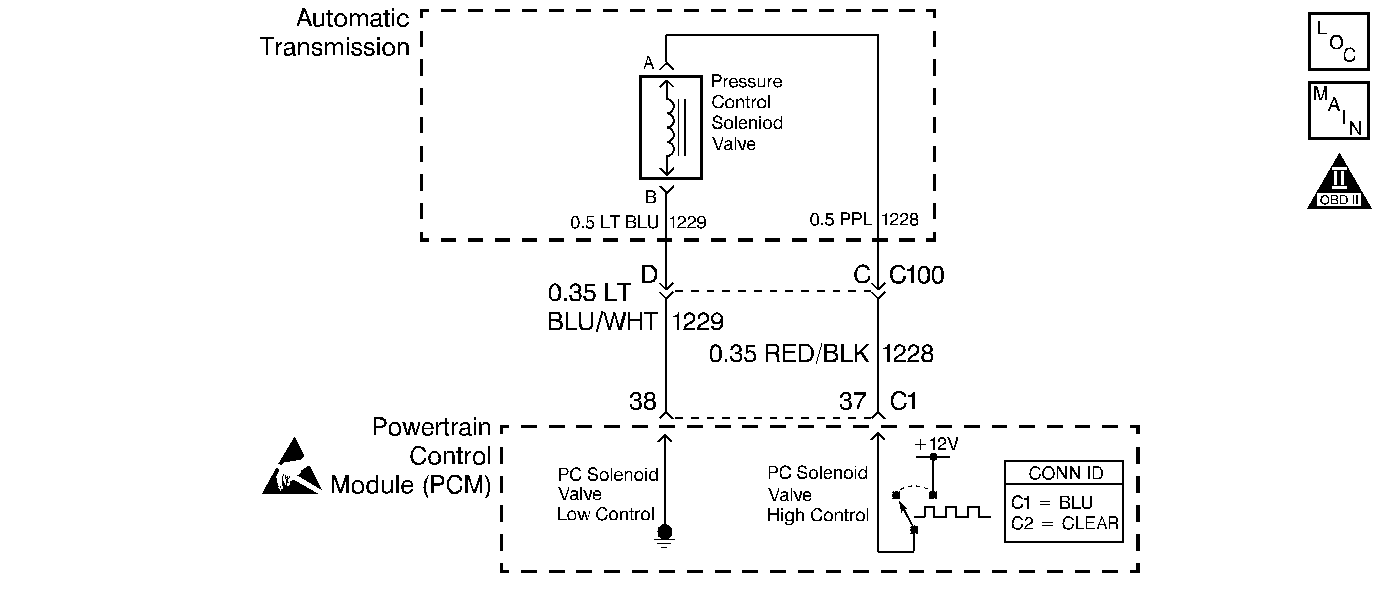
Circuit Description
The pressure control (PC) solenoid valve regulates actuator feed fluid passing through the solenoid into torque signal pressure. The PCM uses a pulse width modulated signal in order to control the torque signal pressure. The PCM compares various inputs in order to determine the appropriate pressure for a given load. The PCM varies the current to the PC solenoid valve from 0.1 amps, for maximum line pressure to 1.1 amps, for minimum line pressure. An internal current monitor within the PCM provides feedback in order to determine actual PC solenoid valve current draw.
If the PCM detects a commanded current draw that differs from the actual current draw by more than a calibrated value, then DTC P0748 sets. DTC P0748 is a Type C DTC.
Conditions for Running the DTC
| • | No Incorrect Gear Ratio DTC P0730. |
| • | No Maximum Adapt and Long Shift DTC P1811. |
| • | The system voltage is 10-17 volts. |
| • | The engine run time is greater than 1 second. |
Conditions for Setting the DTC
The difference between the commanded PC solenoid valve current and the actual PC solenoid valve current is 0.05 amps or greater, for 2 seconds.
Action Taken When the DTC Sets
| • | The PCM does not illuminate the malfunction indicator lamp (MIL). |
| • | SERVICE VEHICLE SOON, SERVICE TRANSMISSION displays on the driver information center (DIC). |
| • | The PCM commands maximum line pressure. |
| • | The PCM freezes steady state adapts. |
| • | The PCM freezes upshift adapts. |
| • | The PCM freezes garage shift adapts. |
| • | The PCM stores DTC P0748 in PCM history. |
Conditions for Clearing the DIC/DTC
| • | The PCM clears the DIC when the condition no longer exists. |
| • | The commanded PC solenoid valve current and the actual PC solenoid valve current are within 0.05 amps of each other for 2 seconds. |
| • | A scan tool can clear the DTC from PCM history. |
| • | The PCM clears the DTC from PCM history if the vehicle completes 40 warm-up cycles without a non-emission related diagnostic fault occurring. |
| • | The PCM cancels the DTC default actions when the fault no longer exists and the ignition switch is OFF long enough in order to power down the PCM. |
Diagnostic Aids
| • | Inspect the wiring at the PCM, the transmission 20-way connector, and the PC solenoid valve connector for the following conditions: |
| - | A backed out terminal |
| - | A damaged terminal |
| - | Reduced terminal tension |
| - | A chafed wire |
| - | A broken wire inside the insulation |
| - | Moisture intrusion |
| • | When diagnosing for an intermittent short or open, massage the wiring harness while watching the test equipment for a change. |
Test Description
The numbers below refer to the step numbers on the diagnostic table.
-
This step verifies that the PCM responds to scan tool commands, and that the DTC could set intermittently.
-
This step verifies that the resistance value is within specifications. Use the J 35616-A connector test adapter kit, in order to avoid damaging the terminals.
Step | Action | Value(s) | Yes | No | ||||
|---|---|---|---|---|---|---|---|---|
1 | Was the Powertrain On-Board Diagnostic (OBD) System Check performed? | -- | ||||||
Important: Before clearing the DTCs, use the scan tool in order to record the Failure Records. Using the Clear Info function erases the Failure Records from the PCM. Does the actual PC solenoid valve reading differ from the commanded PC solenoid valve reading by more than the specified amount? | 0.05 amp | Go to Diagnostic Aids | ||||||
Is the PC solenoid valve resistance within the specified range? | 3-8 ohms | |||||||
4 | Is the resistance greater than the specified value? | 8 ohms | ||||||
5 |
Refer to General Electrical Diagnosis in Wiring Systems. Was a condition found? | -- | ||||||
6 | Inspect circuits 1228 and 1229 of the automatic transmission wiring harness for a short together. Refer to General Electrical Diagnosis in Wiring Systems. Was the condition found? | -- | ||||||
7 | Measure the resistance from terminal D to the transmission case. Is the resistance less than the specified value? | 10 ohms | ||||||
8 |
Refer to General Electrical Diagnosis in Wiring Systems. Was a condition found? | -- | ||||||
9 | Replace the automatic transmission wiring harness. Refer to Unit Repair. Is the replacement complete? | -- | -- | |||||
10 | Replace the PC solenoid valve. Refer to Unit Repair. Is the replacement complete? | -- | -- | |||||
11 |
Is the resistance greater than the specified value? | 10 ohms | ||||||
12 |
Refer to General Electrical Diagnosis in Wiring Systems. Was a condition found? | -- | ||||||
13 |
Refer to General Electrical Diagnosis in Wiring Systems. Was a condition found? | -- | ||||||
14 | Repair the wiring as necessary. Refer to Wiring Repairs in Wiring Systems. Is the repair complete? | -- | -- | |||||
15 | Replace the PCM. Refer to Powertrain Control Module Replacement/Programming in Engine Controls. Is the replacement complete? | -- | -- | |||||
16 | Perform the following procedure in order to verify the repair:
Has the test run and passed? | -- | System OK |
